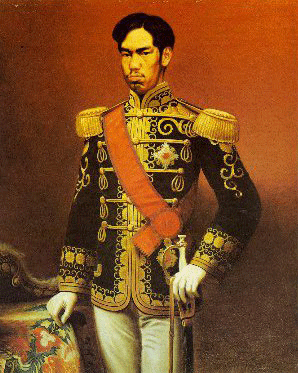The Meiji Restoration: Japan's Industrialization Begins
The Meiji Restoration was the resumption by the Japanese emperor of a starring role within his own government and the first step in Japan’s modernization. 
Emperors had technically been the rulers of Japan for a long time. With the advent of the Kamakura shogunate, however, shogun ruled the army and the people for several hundred years. American naval forces commanded by Commodore Matthew Perry succeeded in convincing Japan to sign a treaty with the United States in 1854. The resulting trade caused inflation in Japan; and the reigning government, the Tokugawa Shogunate proved unable to solve the problem.
The country continued to struggle, and the shogun, Tokugawa Yoshinobu, resigned on November 19. Supporters of the ex-shogun met supporters of the emperor on the field of battle in January, and the emperor’s forces were victorious. On January 3, 1868, Emperor Meiji announced that he was once again in a position of supreme power. This was the Meiji Restoration. 
Forces loyal to Tokugawa Yoshinobu escaped to Hokkaido, one of Japan’s main islands, and set up what they hoped was a rival government. Another battle ensued, and the days of the shoguns ruling Japan were done. The combination of the post-Perry treaties and the restoration of the outward-looking emperor resulted in a Japan that was more much likely to adopt Western models of economics and trade. In particular, Emperor Meiji (whose name meant “enlightened rule”) pursued a path of rapid industrialization. Spurred by an influx of new trade, the country expanded its factories and its manufacturing. In the next few years, the government moved toward a national outlook, rather than the regional focus that had been so much a part of the shogunate lifestyles. The government abolished the title of samurai, in favor of a national army. The government established a national dialect, which replaced regional dialects, and a national education system. The government established a national railway and a national communications network; these accelerated a move for many Japanese people from the countryside to urban centers. The government restructured its legal system, adopting criminal and civil codes modeled after those in France and Germany.
Another area of expansion for Japan as the 20th Century dawned was in the military. The shogunate had felt outgunned by Commodore Perry and his ships and Marines. The Meiji government set about to increase Japanese military might and prestige. The army trained in Western tactics, using Western weapons. Japanese forces had an opportunity to test their military mettle in a war with China, in the late 19th Century, and a war with Russia, in the early 20th Century. Japan won both. |
|



 In 1866, two powerful men named Saigo Takamori and Kido Takayoshi combined forces and gave their support to the emperor, who at that time was Komei. Change did not happen overnight. Emperor Komei died in January 1867, and his son Meiji ascended the throne on February 3.
In 1866, two powerful men named Saigo Takamori and Kido Takayoshi combined forces and gave their support to the emperor, who at that time was Komei. Change did not happen overnight. Emperor Komei died in January 1867, and his son Meiji ascended the throne on February 3.  The government also created a constitution, in 1889, and an elected assembly named the Diet, in 1890. The vote, however, was available only to the wealthiest one percent of the population (a situation that remained until 1925).
The government also created a constitution, in 1889, and an elected assembly named the Diet, in 1890. The vote, however, was available only to the wealthiest one percent of the population (a situation that remained until 1925).
